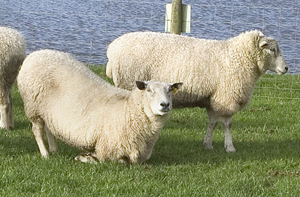
Sheep farmers can break free from the footrot cycle by implementing a whole-flock control programme of vaccination thanks to new supplies of a footrot vaccine.
Footrot is the most common cause of lameness amongst sheep and is one of the most important health and welfare issues facing British sheep farmers. The disease, which can result in reduced mobility, impaired fertility and reduced growth rates in lambs, is caused by two different bacterial infections: Fusobacterium necrophorum which infects the hoof space and Dichelobacter nodosus which causes subsequent infection in the foot itself.
Paul Williams MRCVS from Schering-Plough Animal Health states that, "Once footrot enters the flock, both animals and financial margins are likely to suffer. This is because sheep will lose body condition and rams will fail to perform properly. These factors can result in lower lambing percentages and higher mortality rates in lambs, which will generally be much smaller at birth due to their mother's suffering.
"Ultimately, farm profits will be hit, not only by the loss of lambs and lower finishing weights, but also because of the additional costs associated with treating diseased animals, such as the administration of antibiotics and the time consuming process of walking sheep through expensive footbath products."
However, Footvax, the only footrot vaccine that is currently licensed in the UK, is now available again following a short stock-out period. The product, which can be used at any time of the year, is available 'over-the-counter' from agricultural traders and veterinary surgeons and provides effective treatment and protection against 10 strains of the bacteria which cause footrot.
It is therefore possible once again, and indeed advisable for sheep farmers to vaccinate their animals now, as Mr Williams explains: "Footrot is mainly spread from sheep to sheep and it is therefore good practice to vaccinate the whole flock before footrot levels increase so that sheep can build up an antibody response to the bacteria that cause infection."
Paul concludes by saying that, "There is a misconception that vaccination against footrot should only take place during periods of dry weather. But in reality, Footvax can be used to provide effective treatment and protection at any time of the year to tie in with when footrot is a problem in the flock. It therefore makes sense for farmers to take action as soon as possible in order to reduce lameness, improve animal welfare and to reduce the financial implications and time and labour inputs associated with treating lame animals."
